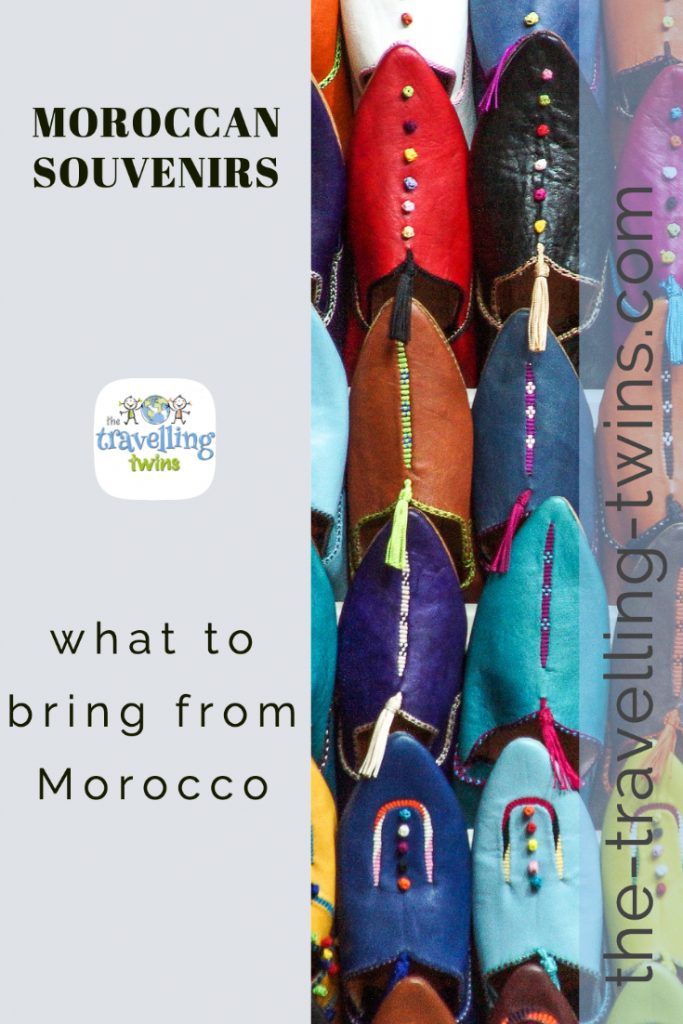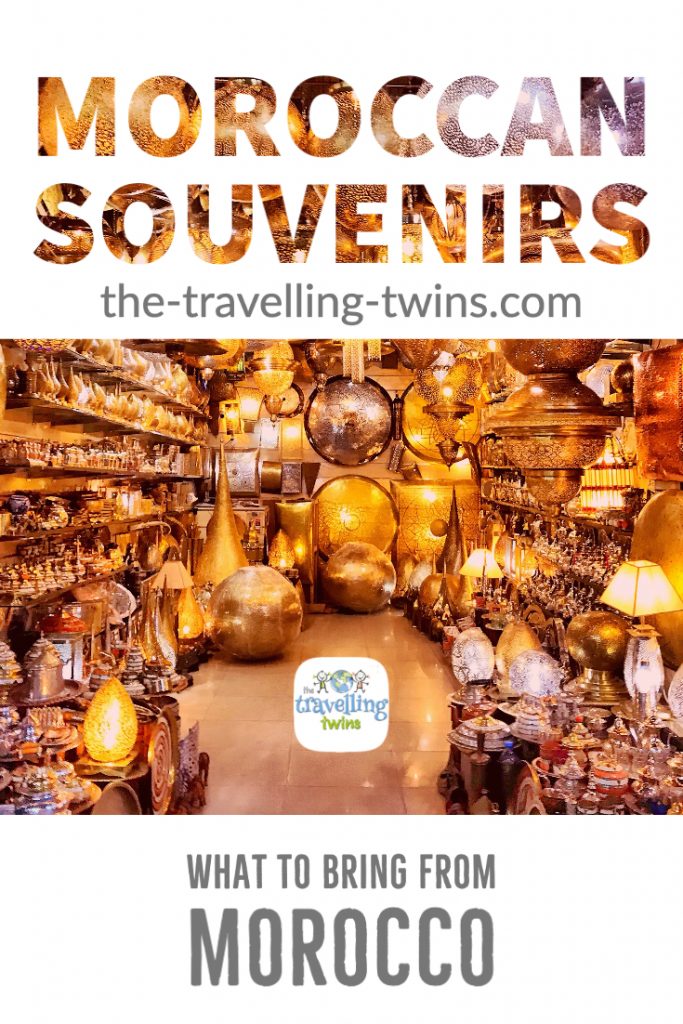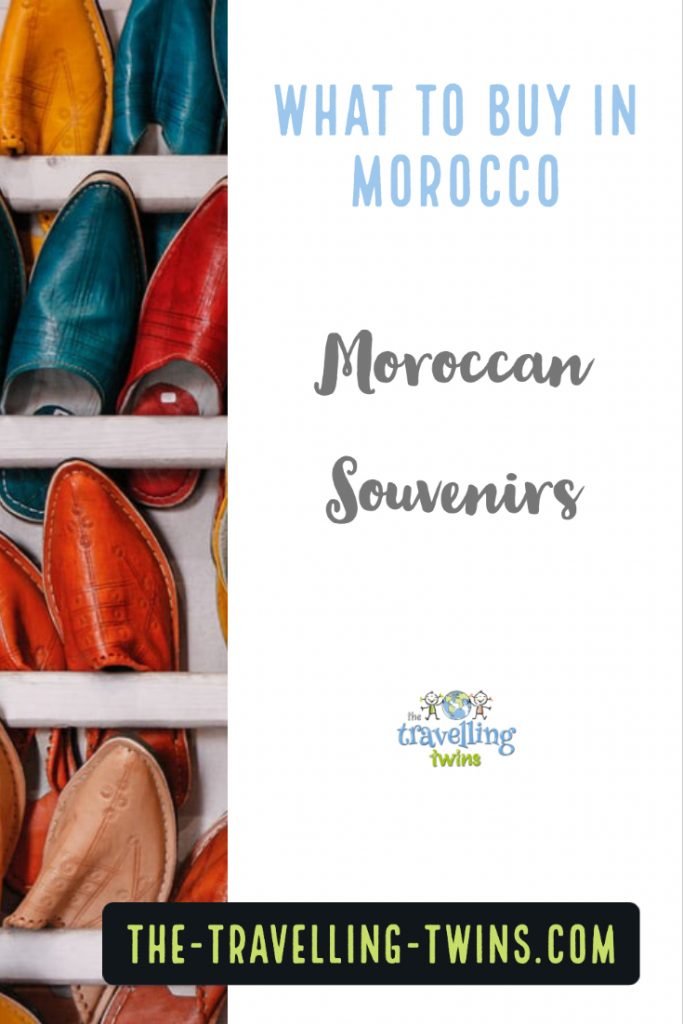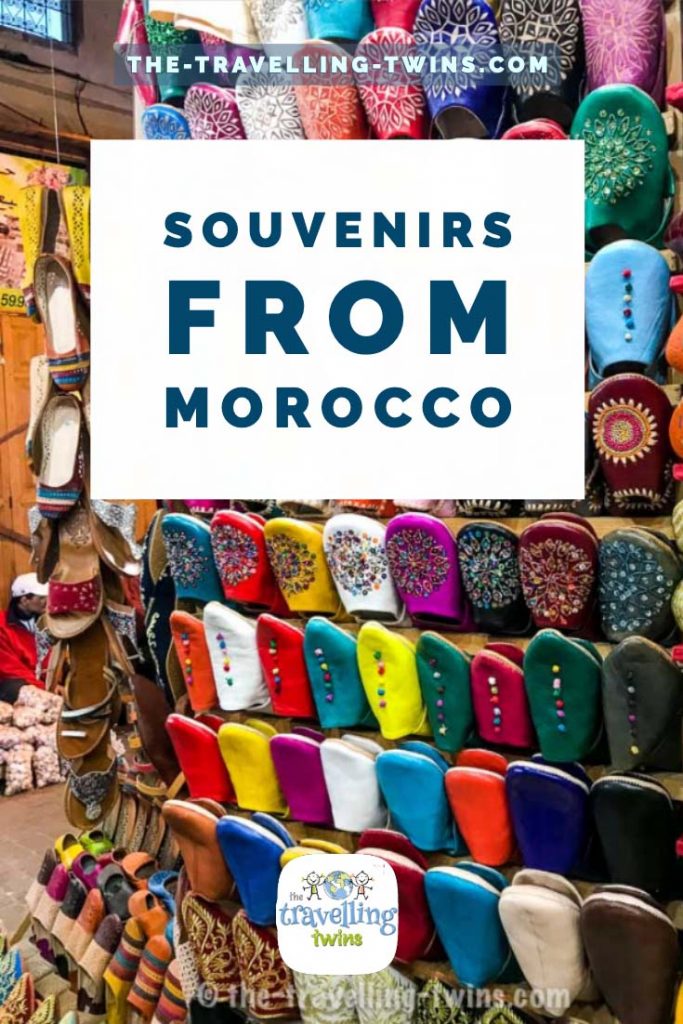
One of the things we love about the travelling life are the opportunities to buy exotic goods from the countries we visit. Morocco is immensely rich in decorative craftsmanship, and easy to reach from Europe, especially from Spain and Portugal.
Sometimes you only realise after leaving somewhere that you have just missed the best market for a particular craft. Our travels in Morocco highlighted this especially. Moroccan craftsmanship isn’t homogenous across the country, and different towns have their specialities. In this post, I have described what items to bring home from your trip to Morocco and where to find them.
Morocco is a souvenir hunter’s paradise and it is not hard to see why all the hype. Whatever the material there is a Moroccan tradition of working it by hand to enrich it with fine craftsmanship. Moroccan craftsmen pour their hearts and souls into their work, often in family-run workshops and shops where craft knowledge and Islamic patterns pass from generation to generation. Moroccan craftsmanship brings out the best of the artisans’ skills together with the qualities of raw materials. These may be silk, leather, wood, glass, silver and brass. This use of simple traditional materials also means the items you buy will last and age gracefully.
Moroccan souks, bazaars and medinas.
Shopping areas in Morocco fall into broad categories. A souk (also souq or suq) is a market and they generally specialise in one kind of thing whether spices, fish, vegetables, meat, livestock, clothing or jewellery. Bazaars are large shops under one ownership – again generally specialising, but offering larger more expensive items. The Medina is key to it all. Medinas are Morocco’s historic town centres and as well as souqs and bazaars, the streets and alleysways of a typical medina will be full of stalls, kiosks, tiny shops and handcarts all offering an array of crafts, and foodstuffs. Medinas are the heartbeat of any tourist town and they are the place to go for souvenirs, whether cheap or expensive commonplace or rare.
You can find just about anything in the medina but there is a catch. You will have to navigate the crowd to find what you are looking for. There are also some insider rules you should know, especially if you are new to Morocco. Nevertheless, medinas are the place where your Moroccan shopping experience should start.
How to Avoid Fake Products in Morocco
As in any other market in the world, you should always look out for counterfeit products. However the good thing about Morocco is that it is easy to see genuine craftsmanship. Moroccan goods are evidently handmade from solid materials. You can see the unevenness of the hammer blows on the silverware, the deep polish on solid wood and the cuts where metal wire has been inlaid into wood or bone. If any of these items were machine made they would look very different. Moroccans genaraly are selling craftsmanship made from natural and solid but not precious materials. Probably the most precious material you will find Herę will be silver, and with its beaten surface and slight tarnish it is easy enough to recognise.
We have a family joke that the only country where the souvenirs are made in the same country where you buy them is China, however in Morocco at least you can see almost at a glance what is real. Perhaps the most difficult things to see the differences between real and fake are in clothing and carpets. This is because fake fabrics are difficult to tell apart, but fake handmade craftsmanship is easy to detect. However we found that most carpet vendors will be happy to offer you a cup of mint tea while they tell you at great length about which of their wares come from which source and what materials, and why some are five times the price of others. After twently minutes of such a converstaion, if you still can’ t tell the difference with our own eyes, then at least you can make up your own mind about how much to pay.
Morocco also has traditionally been a land of trade, and you will find Berber, African and Indian crafts here as well as the more common locally made Moroccan-Islamic patterned wares. With these items you may be more likely to buy fake since there are fewer wares to compare, so you won’t have the chance to become an instant expert. Always a good idea is to talk to a range of vendors. You don’t have to buy after every such conversation, but of course it is nicest to buy from the vendor who charms you both with his stories and his transparent love for his wares, because that adds a layer of interest to the memories you will bring home with your souvenir.
Other tips for avoiding fake products in Moroccan markets apart from sticking to the local Moroccan products is to buy from bazaars where you can rely more on reputation. This will mean for example that your silk scarf is more likely to be of genuine silk, however you will pay significantly more for the same genuine product here than you would pay for an equivalent also genuine product ten metres from the bazaar’s front door.
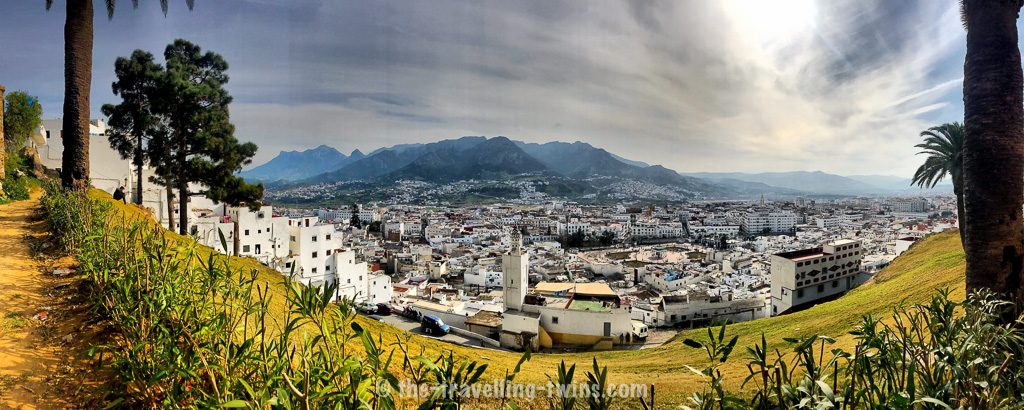
Read about Medinas of Morocco
Being thrifty in Morocco
In Morocco, every vendor will expect that you bargain the prices of the products; it is deep in the culture. Probably every product is marked at a higher price as the seller knows you will ask for a reduction. However, haggling can be difficult if you don’t know the average price of a product. So a bit of research will help you save money.
There are some general rules, for example the same item in Marrakech will be more expensive than in Essaouira, an item in a Bazaar will be more than the same thing from a stall in a souq. However often of course you won’t find exactly the same item or you won’t have the chance to trek back and forth between two cities. Here we will tell you which towns specialise in which crafts, and beyond that, your best game plan is to make your souq-wandering into a mini quest to find the best example of whatever crafts you find attractive in that town, and check the prices as you go. The catch here is you have to remember where you saw it! For this, you can pick up business cards or drop pins in google maps.
What to buy in Morocco
What you can buy in Morocco depends on where exactly you go. While it is possible to find almost anything, in some souks, especially in Marrakech, some towns and regions specialise in certain materials and crafts and you will get better choices and prices there.
I have given you here a run down both by speciality and by city. But of course it isn’t a precise science. Half the fun is in becoming your own expert. Take my words as a jumping-off point to avoid major pitfalls and then enjoy embarking in your own connoisseur learning curve!
Argan Oil
Argan oil is painstakingly ground by hand from the nuts of trees which grow only in Morocco. As you travel by road through southern Morocco you may see goats climbing small trees, sometimes half a dozen animals in one tree. These are the Argan trees. The oil is renowned for its high content of vitamin E and essential oils and is used both for culinary and cosmetic purposes.
Authentic argan oil is typically thick, with a golden colour and nutty aroma. It is sold in small bottles as oil. There are many products that are infused with argan oil, some of the most common ones are argan hand lotion and argan shampoo. Keep in mind that argan oil is only made in Morocco, so if you want it, then do your research on the exact oil you want and stock up while in the region between Agadir and Essaouira. There are also Argan forests south and east from Agadir however as a tourist these areas are less likely to be on your itinerary
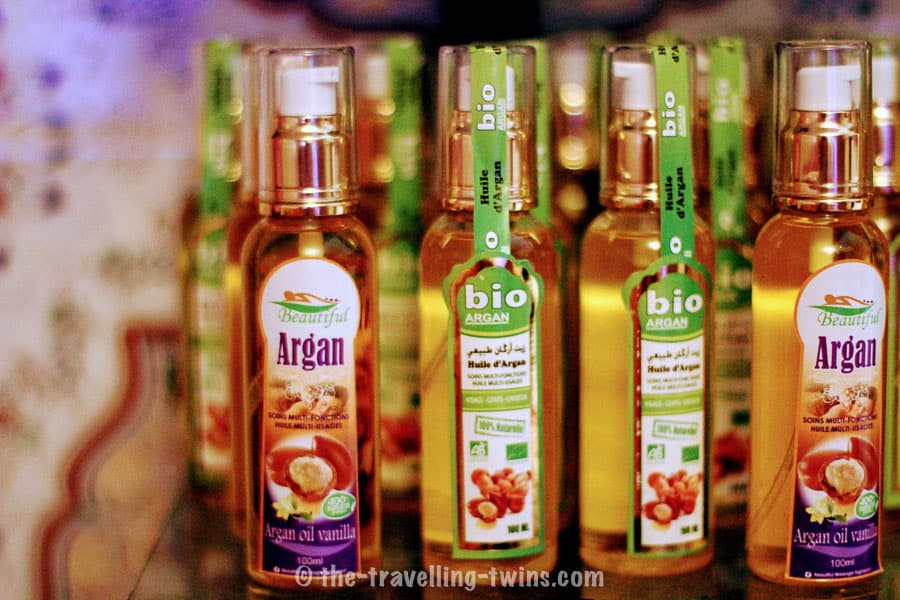
Best place to buy argan: Essaouira, Agadir, and small villages between the two, where Argan Oil is extracted in traditional way by women.
Price: The price varies depending on the market at the time you visit. But generally, for 100 ml of cosmetic argan, the price should be between 50 and 75 dh or at most 150 dh.
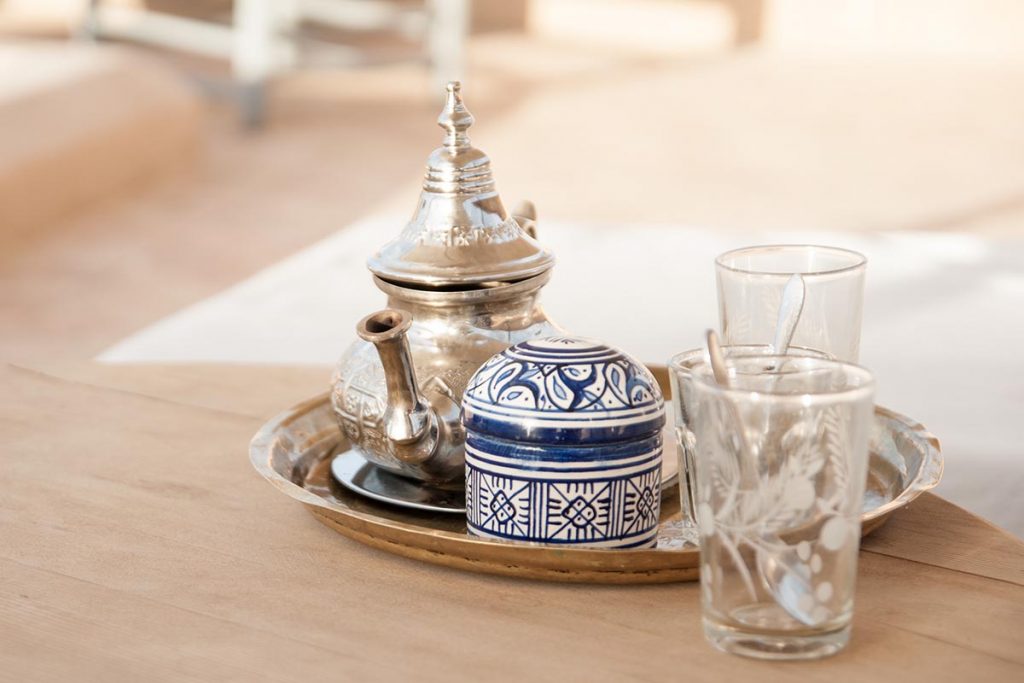
Do you know that Morocco has its own Hollywood, Do you know what is the name of Moroccan men’s outfit ? Can you smoke hash in Morocco – read Facts about Morrocco
Zellige (Tilework)
One of the most evocative images of Morocco and Southern Spain are tiled walls in coloured intricate Islamic patterns. These wall panels are not made by tiling onto the walls but are cast in panels. Each piece of the geometric pattern is chipped by hand from larger handmade tiles and then placed face down.into its place in the puzzle. Plaster cement is then poured on and allowed to set before the whole panel is lifted from the floor and put in place. This is an ancient Moroccan tradition and the work is very skilled. If you are wondering how you can transport home a tile wall, the work is available in small pieces.
The craftsman doesn’t arrange the tiles visually, instead he memorises the patterns and then cuts and arranges the shaped tilesupside down before sealing them. Watching on as tilework is made is a treat on its own.
Places to buy zellige tilework: Tetouan and Fez
Prices for a piece: It depends on the tilework, as well as the size and the pattern and how intricate or elegant it is. Small parts can go for a few hundred dirhams, while tile fountains can be worth up to thousands of dirhams. Keep in mind that some tilework can take months to complete.
Ceramics
You will find hundreds of variety of handmade Moroccan ceramics and pottery when you visit, the country, including cups, bowls, plates, and decorative pieces, among others. Bright colours are the norm in Morocco, but you can also find items in neutral colours in souks.
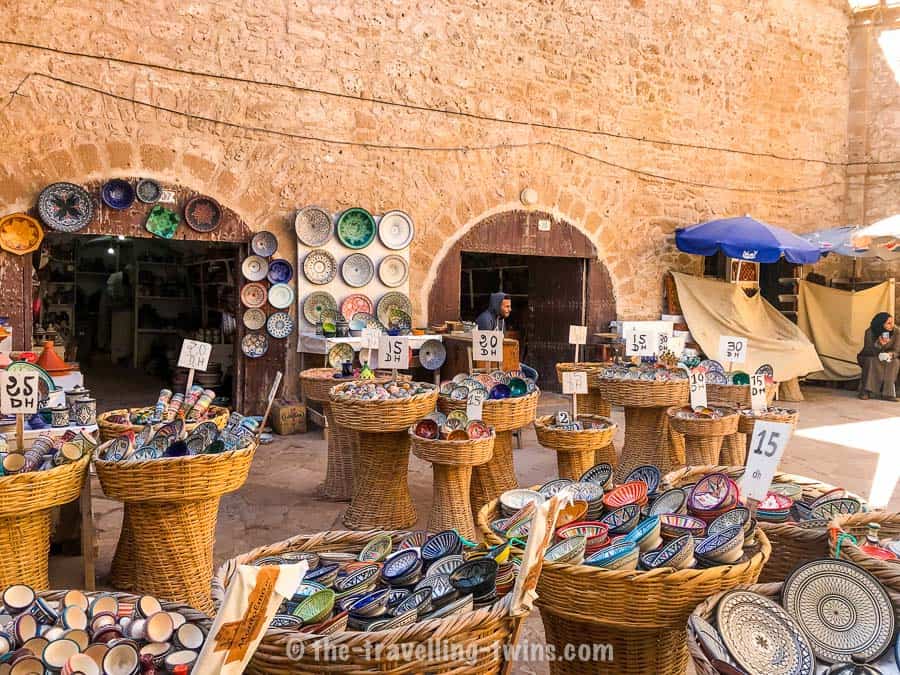
Most cities in Morocco have small stalls that sell a piece or two ceramics to tourists, but you can also find wholesale shops selling in bulk, which you are likely to get better deals. If you are looking for a particular style or colour, just ask the vendor.
The best way to transport ceramics back home is to ask the shopkeeper to wrap the items for you, and then you can add more bubble wrap later if you consider it is needed.
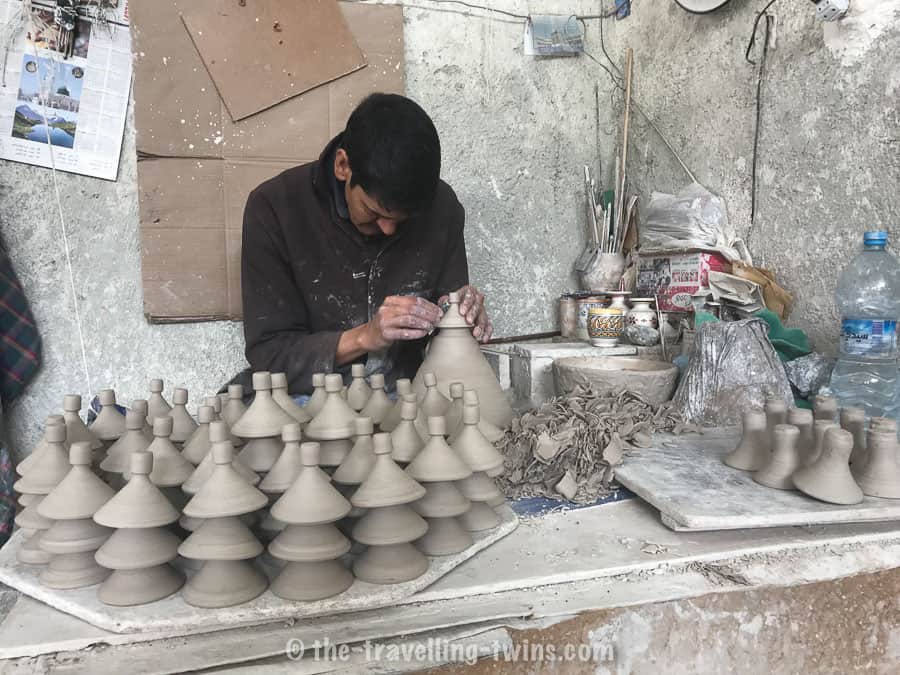
Note that making ceramic products take a lot of time and effort, so if you are planning to buy one item from the maker perhaps this is one time not to haggle so hard.
Places to buy ceramics: You can find ceramics in almost every city in Morocco. Each town has its own style and colour culture. However, the best cities known for quality, authentic ceramics are Fez, Safi, and Meknes.
Prices for ceramics: Small bowl can cost as low as 20 dh while larger pieces can go for up to 200 and 300 DH.
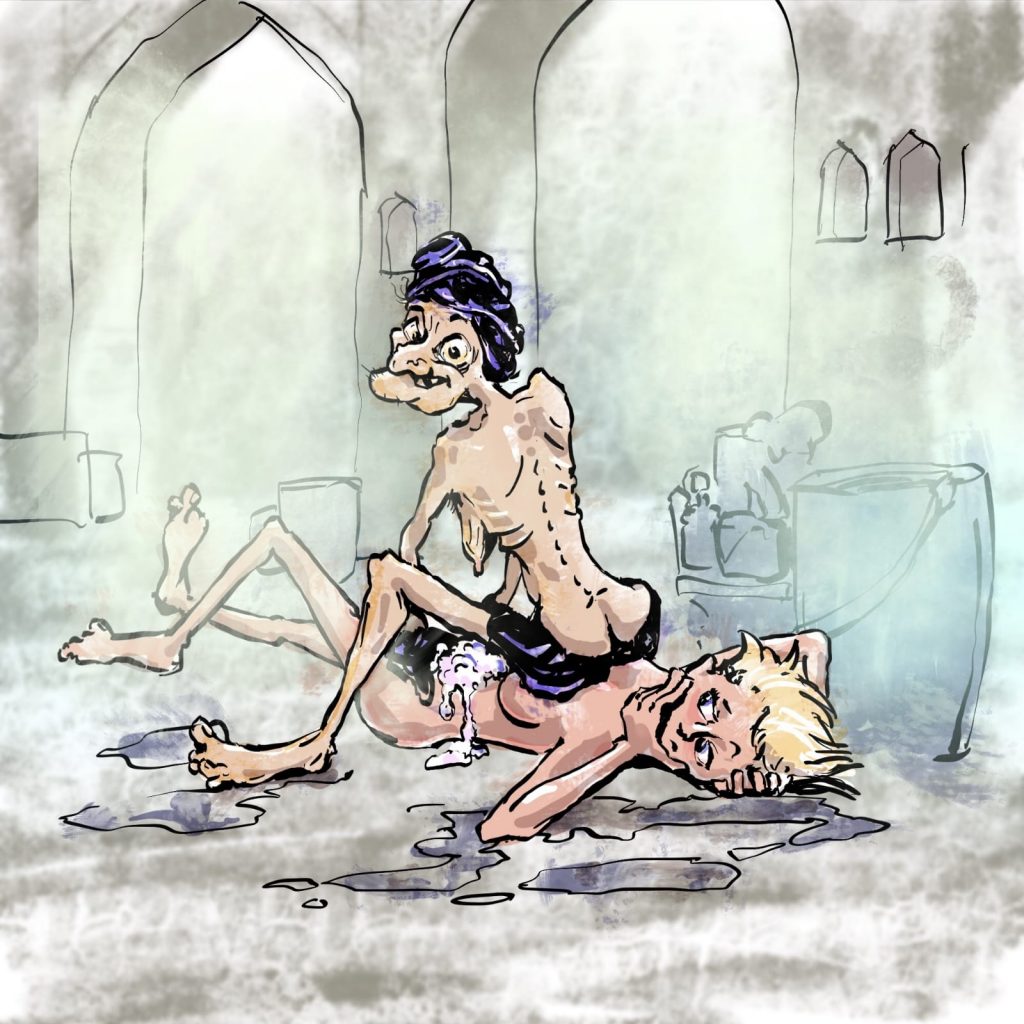
Traditional Moroccan Hammam steam bath read about my experience
Clothing
There are lavish clothing styles to buy in Morocco, from fanciful dress to simple djellabas. The majority of clothing items in souks in Morocco are handmade and very cheap. For a lady, the exceptional items are tunic tops as well as linen dresses. Be aware that with bright colour clothes my not be colour fast and consider how you will wash them.
Another excellent clothing product to buy is flowy kaftans. They are fabulous to be worn around the house as well as outside and a pool or beach cover-up.
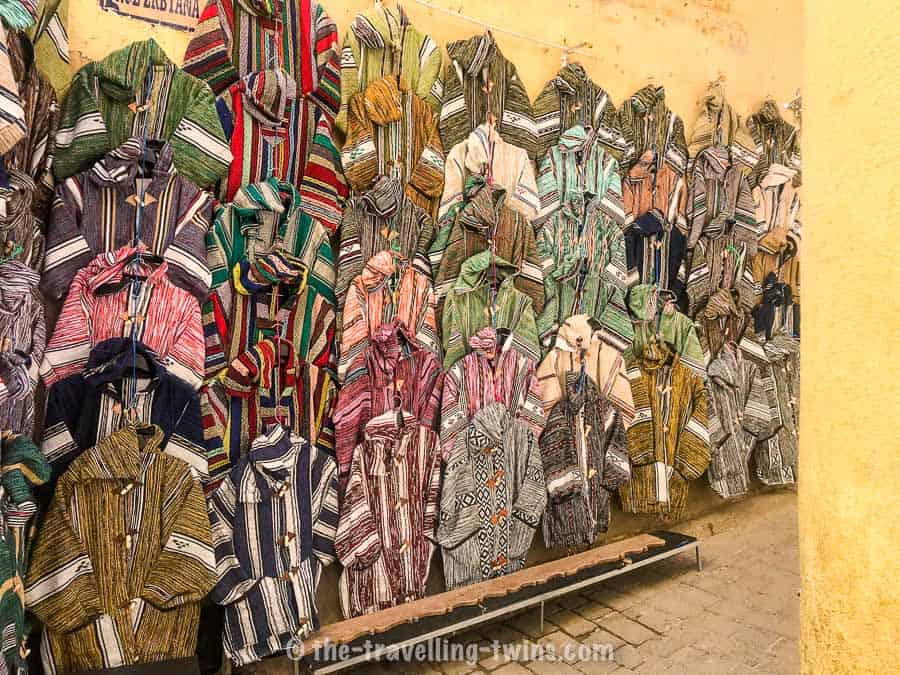
For men, there are plenty of stunning traditionally woven hats and bespoke items if you have time on your side. You may also be interested in a thobe, which is perfect for relaxing during the hot summer months.
Note that you may look good in specific clothing in Morocco, but when you reach home, it seems totally awkward, so be careful what you buy.
Consider also shopping for clothing items outside the markets. Many cities in Morocco have new shopping hubs with boutiques selling products inspired by traditional patterns and styles but with a modern touch. These are probably the best options if you are after the colours and design esthetics of Morocco that would also transition when you change the settings back home.
Places to buy clothing: You can find the best clothing items just about anywhere in Morocco. The only thing which that they will vary in style and design. If you are after a modern design look in shops in Cassablanca.
Price: It also varies with the region, but pure kaftans can cost between 50 and 100 dh and less if you find a bargain. Shirts can go for 1000 dh, while fancy takshita dresses can cost between 1500 to 15000 dh.
Spices and dried foodstuffs
If you are planning to visit Morocco for spices, which the country is actually known for more than anything else, we have an informative article about spices in Morocco, which we recommend you read first.
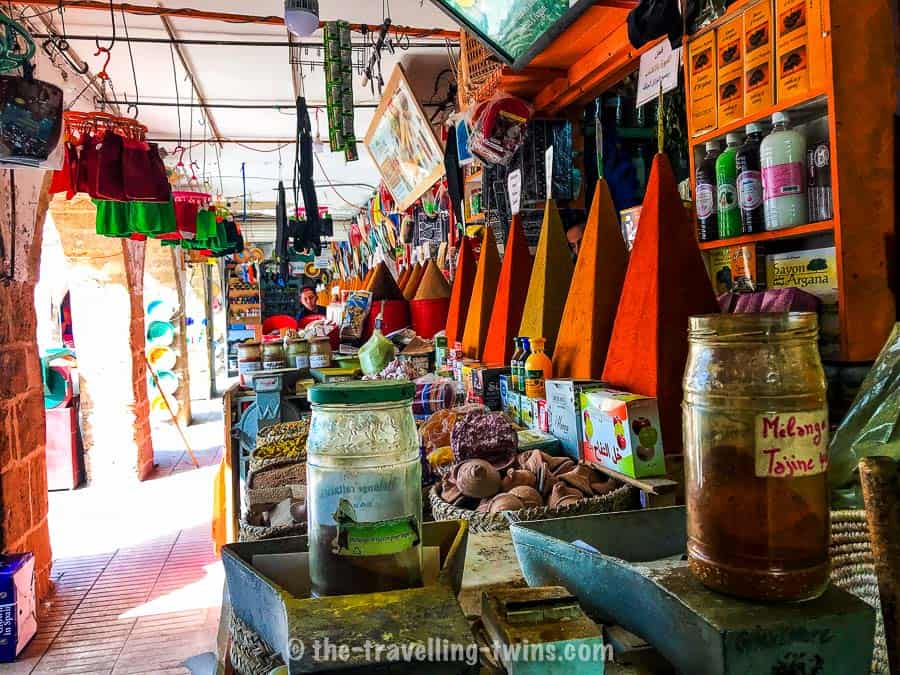
The best thing about buying spices in Morocco is that they are of excellent quality then you will find in most markets around the world. They are also quite affordable and easy to carry back home. The most common spices are saffron, cumin, turmeric, and ras el hanout. When purchasing a spice in Morocco, remember to ask the seller if he or she can grind fresh for you. Note that to experience the authentic taste of the famous Moroccan spices, make sure they are freshly ground.
Don’t just throw your money in spices you are not going to use. Remember, you are buying something that you are probably not going to find it anywhere else in the world, so shop wisely.
Other spices include paprika, cinnamon, and white pepper. But you can also buy food items such as walnuts, almonds, dates, figs, and olives in Morocco. Culinary grade argan oil is also one of the most prized items in Morocco.
Buying spices should wait until the end of your trip so that you bring them home when they are still fresh.
Places to buy spices: All over the country. But saffron can (authentic ones) can only be found in Tailouine. Keep in mind that the freshness of these spices depends on the month of the year when they are harvested.
Prices of spices: Prices of spices are based on weight – 100 grams. A gram of saffron can cost up to 70 dh, while cumin, turmeric, and paprika cost 20 dh per gram. Ras al hanout costs 30 dh per gram, and ginger, pepper, and cinnamon cost 15 dh per gram. Dry min goes for 10 dh per gram.
Lanterns
A handmade Moroccan lantern or lamp can be a great souvenir to bring home. There are wide ranges of sizes, materials, and weights. The most affordable lanterns are the lightweight ones, which are typically made from aluminium. But if you want something that will remind you for many years of your trip to Morocco, you should invest lanterns made from heavy-duty metals.
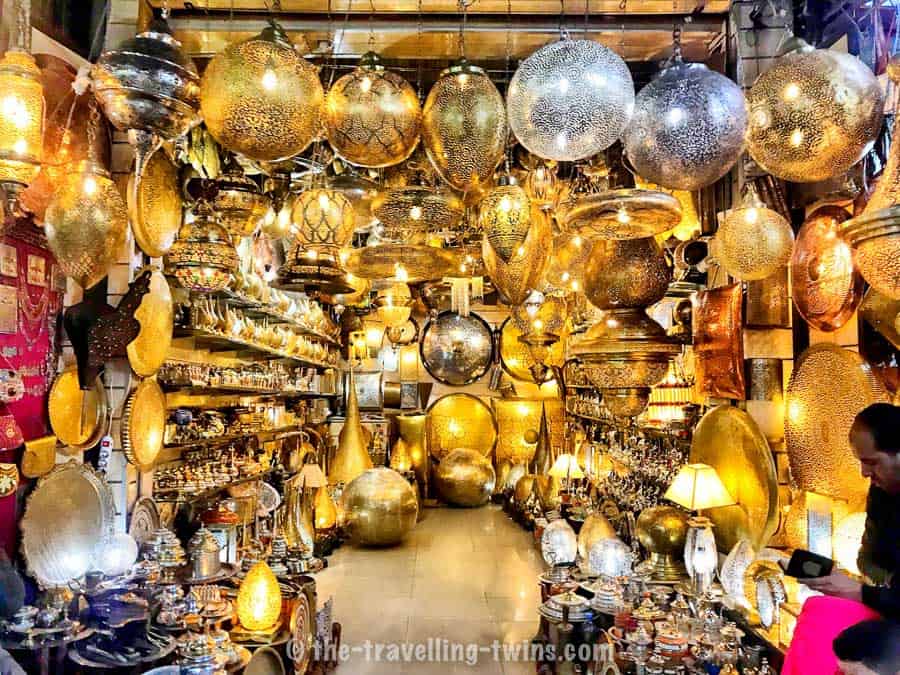
Best places to buy: The best thing about Moroccan lanterns is that they are the same no matter where you buy them. But because different artisans make them, don’t be surprised to find some subtle differences.
Prices of Moroccan lanterns: lightweight lanterns are usually between 100 dh and 500 dh, while heavier ones may cost from 300 dh up to 2000 dh.
Leather goods
Moroccan leather goods has been made the same as hundreds of years ago, meaning authenticity is maintained. The tanning market in Fez is one of the most photographed sites in North Africa. The traditional leather is used to make numerous things, including leather bags, poufs, slippers, and book bindings.
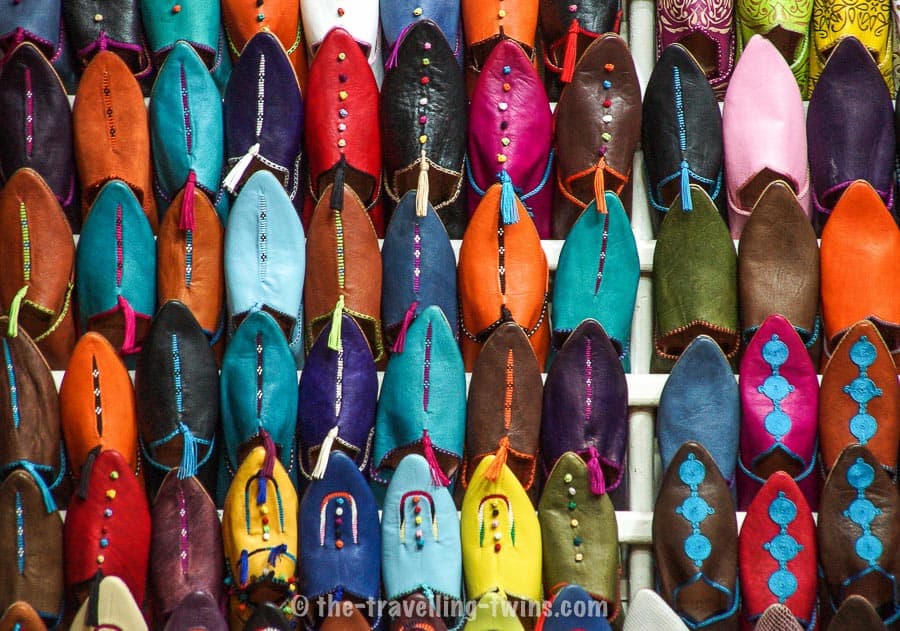
The leathers come from different types of animals, such as cow, camel, goat, and sheep. This means that you will find leather of different qualities depending on the skin type.
The most common places to buy leather in Morocco are Fez and Marrakech. Some numerous shops and workshops sell leather goods in these two areas. You can also have them make for you a custom leather product if you have time, and by having time, we mean two days at the very least. It is also a good idea to come with a drawing of an image of what you want custom-made so that the craftsmen can have an easy time creating your product.
Best places to buy leather goods: You will find high-quality leather and leather products in Marrakech, Fez, and Rissani.
Price of leather products: It depends on what you want; a medium leather bag can cost about 450dh, leather slippers about 50dh, while leather jackets between 800dh and 2500dh.
Hammered metalwork
Moroccans are known for creating engraved metals and buy one, or a couple will make sure you have something that will remind you of your time in Morocco. Most of the metalwork products are decorative products, but there are also products such as metal trays, teapots, and jewellery. The products are usually machine stamped or hand stamped.
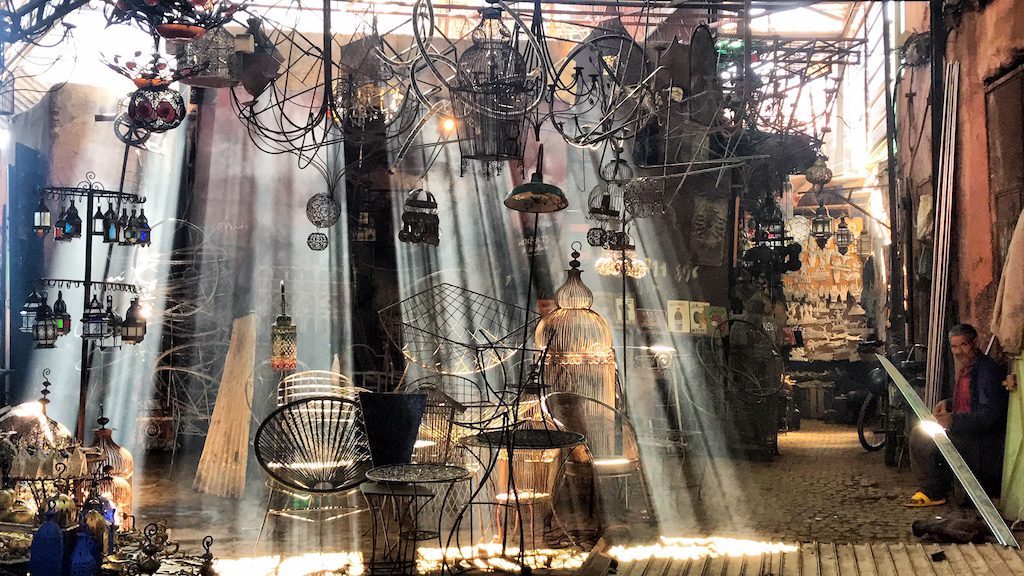
You should find metal workshops in most of the cities in Morocco. When buying one, be sure to inspect to ascertain which are made etched by hand and machine. In Moroccan tradition, hand etching is considered more valuable than machine etching. It is not hard to tell between devices created from hand-created. The former is uniform while the latter is slightly inconsistent.
Best places to buy metalwork: Get your metal etched products at Fez and Sefrou
Prices for metalwork: It depends on the type of product you want. A handmade teapot cost between 150 to 300dh. Etched plates will set you back between 100 and 500dh depending on the design and size. But if you are on a budget, plain copperware will be less expensive.
Musical instruments
Before buying a musical instrument in Morocco, you should know that they come in two types; indigenous inspired and Arab. There are wide ranges of music instruments in Morocco, which can be attributed to the influence of the Gnawa musicians from southern Morocco. One of the most common music instrument is the oud’s. It is an Arabic guitar, and you can find it anywhere in the country. For authentic Gnawa instruments, you may want to visit the southern coast of Morocco or Sahara. Drums are also ubiquitous in Morocco. They are cheap and quite smaller in size, which makes them perfect souvenir, especially for young children.
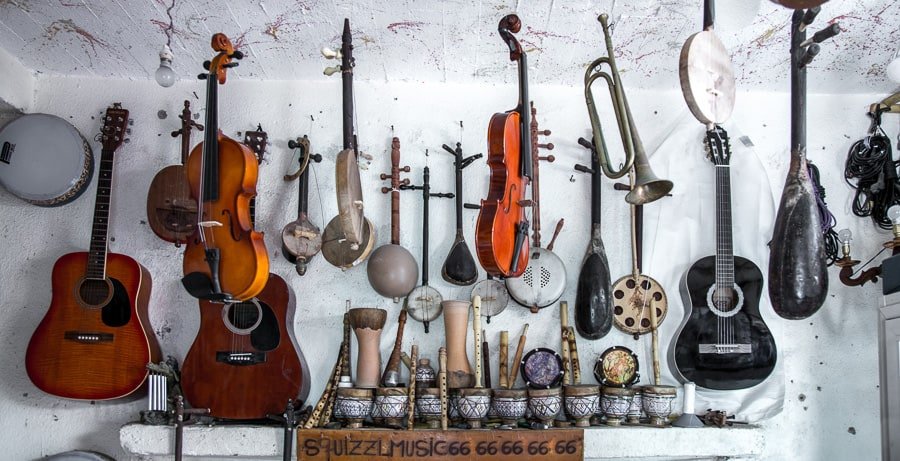
Best place to buy music instruments: Find them at Essaouira, Marrakech, as well as the cities near Sahara.
Price of music instruments: A small drum will cost you about 100dh. Gnawa cymbals can go for 10 to 20dh.
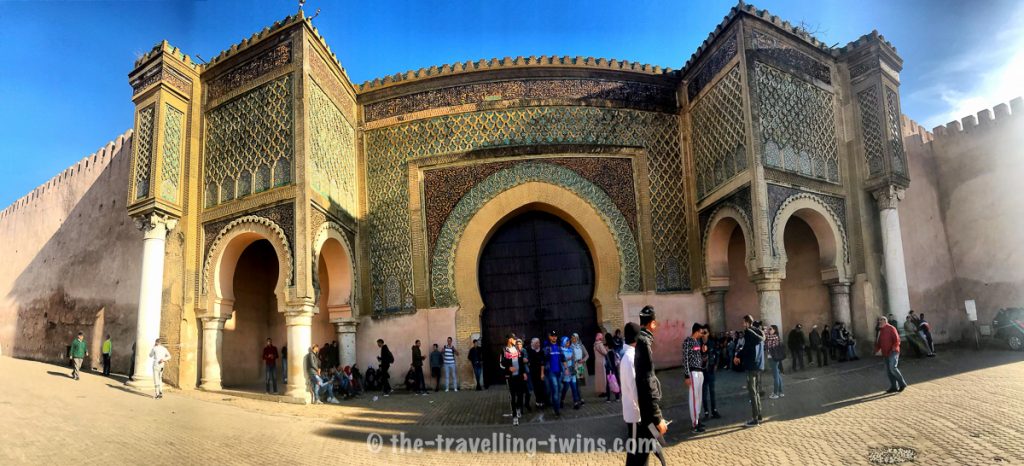
Read the fascinating story of how north Africa plundered the Mediterranean for slave labour – Including for the construction of Meknes: Morocco’s answer to Versailles
Rugs and Carpets
There is no better place to buy rugs and carpets than a country that loves bright colours. Moroccan rugs and carpets are one of the most beautiful you will ever come across. The best thing about buying a carpet in Morocco is that it is very cheap.
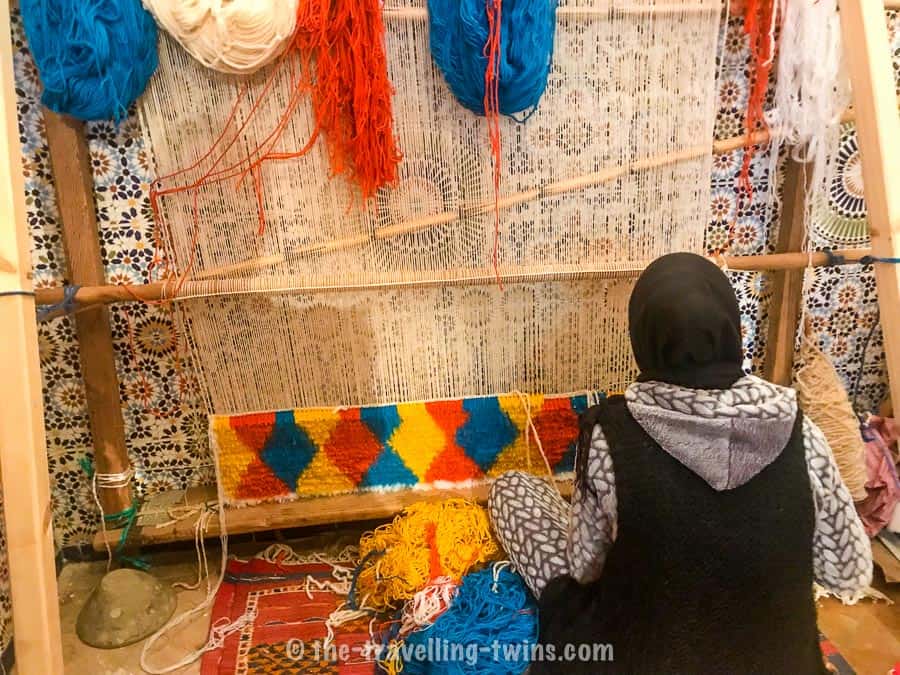
Buying rugs and carpets in Morocco is a whole different experience, and you will need all your bargaining skills. But you should save this activity on the last day of your trip. Take your time to pick what you want and don’t show that you are interested in a specific item, as this is the perfect opportunity for the seller to quote you’re an astronomical price. Generally, the costs of the rugs and carpets will depend on how old the item is as well as the size.
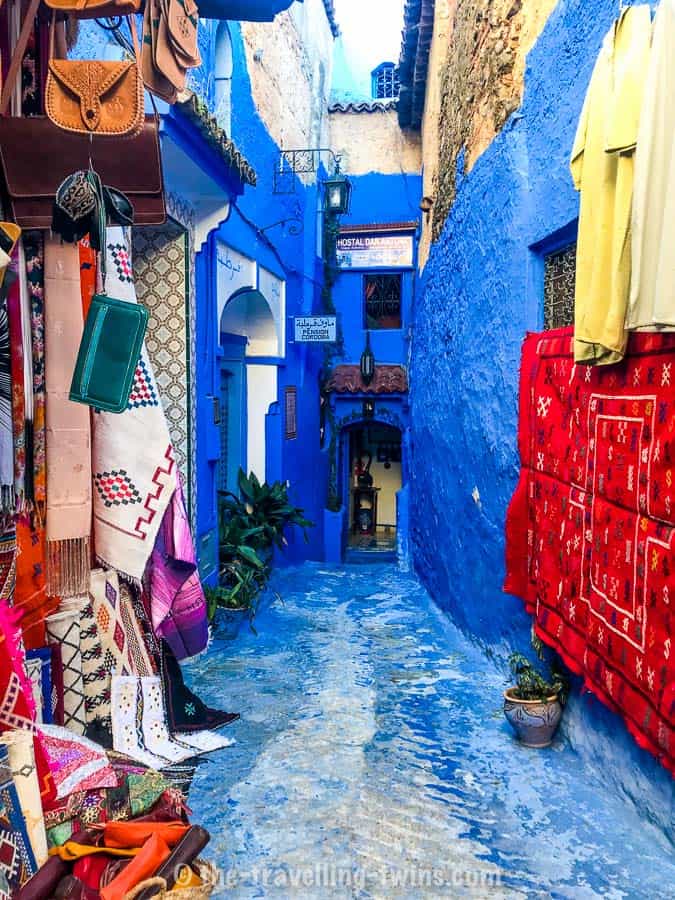
Best place to buy rugs and carpets: Locally produced rugs and carpets can be found anywhere in Morocco.
Prices of rugs: A good rug might cost you on upwards of 100 dollars.
If you don’t have a specific item in mind to buy, but you know the city you want to visit in Morocco, here is a small guide on what to buy in the major cities in Morocco.
What to buy in major cities in Morocco
This should give you an easy and quick reference:
Casablanca
There is an excellent chance. Casablanca is the biggest city in Morocco. If this is where you plan to stay for the entirety of your journey, there are many things you can buy:
- Pottery – you can find many pottery products in Casablanca, especially Rabat, where they are made.
- Clothing – there are lots of boutiques in the city where you can buy great pieces of clothes with both traditional and modern touch.
- Antiques- while they are not cheap, you will find many items from the era of French occupation in Casablanca.
Tangier
Tangier is a blend of Morocco and some Europe and the Middle East. It is something that gives it a different, unique feel from the rest of the cities in the country.
- Woven products – it is just great that the city is home to the weaver market, Fondouk Chejra.
- Clothing and Riffian-styled tasselled hats.
Fez
Fez is the city of artisan and has been so for many years. It is a go-to destination for people looking for Moroccan handicrafts. There are still many traditions in this city as well as quality products.
- Pottery goods
- Leather goods
- Fez hat
- Zellige (tilework)
Marrakech
This is the only city in Morocco where you can find pretty most everything because it is a tourist and trading centre. The price of goods is also higher than in other places in Morocco due to the high number of tourists in the city, which means you will need to be more street smart.
- Saffron and other Moroccan spices
- Rugs and carpets
- Lighting fixtures and lanterns
Essaouira and Agadir
These two cities are known for argan oil due to their proximity to the argan growing plantation. These regions also contain items you cannot find at any other pace in Morocco.
- Argan oil
- Gnawa music instruments
- Wooden items such as trays
What souvenirs have we bought in Morocco?
- spices – great idea, still have some left
- small bottle of argan oil
- wooden boxes for presents
- small ceramic dishes – small tajine dish
- leather goods – small wallets, pencil cases – all great
- shoes – not such a great thing
- we tried to buy Jelaba for kids but all were badly made and felt uncomfortable
- we did not buy a carpet
Souvenirs from Morocco – Share it, Pin it for later
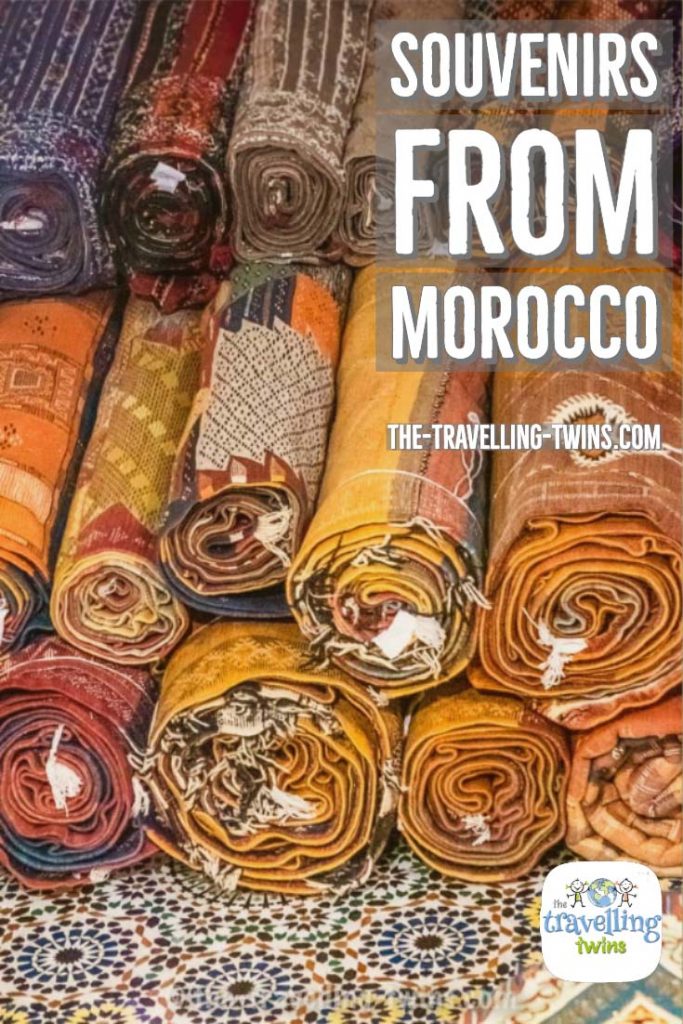
Privacy Policy Disclaimer
This website uses affiliate links for income and support.
If you like our website, please consider using these links. You will be directed to the vendor, and we will get a small commission on your purchase price at no increased cost to you.
We have researched facts stated here as far as practicable but please check anything critical before committing your time and money. We do not claim any special knowledge or expertise, and we are not consultants for our readers.
